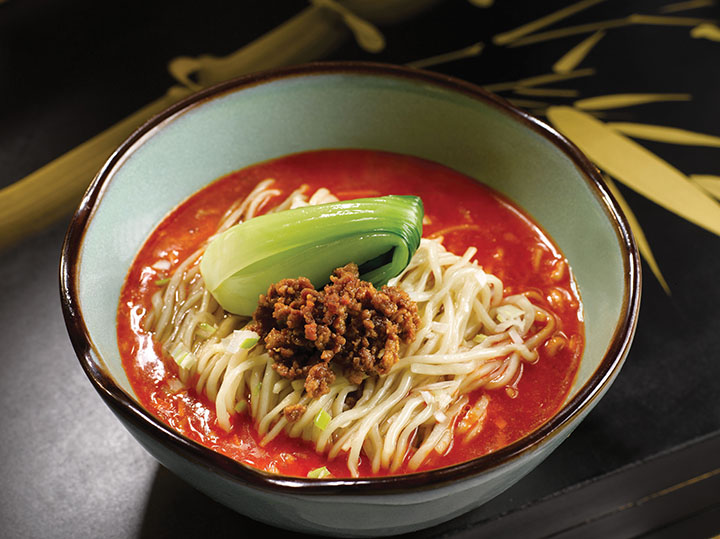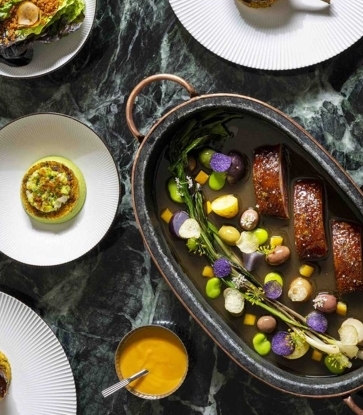After all, F&B head honchos often look across the world for inspiration. When a small gourmet butcher in Manhattan starts offering dry aging services for example, other businesses halfway across the globe are inspired to do the same. When a mixologist takes out spirits from his concoction as a challenge to create the same body without the alcohol, others too might be tempted to take up the task.
It's almost like a butterfly effect that culminates into a trend. Here’s 10 to look out for this year.

Cantonese fare like sweet and sour chicken has defined Chinese food in many of the world's most cosmpolitan cities. But the hot and sour flavours of Sichuan cuisine are fast on the rise. In 2016, Café China in the heart of Midtown, Manhattan, was awarded one star by the Michelin Guide to New York City for standout dishes like a succulent Chungking chicken that comes with a generous amount of dried chillies. In Singapore, Shisen Hanten became the highest Michelin-awarded Chinese restaurant with two stars for its mastery of Sichuan’s complex flavour profile that comes through in the mapo tofu, a deceptively simple dish.
The Rise of the “Grocerant”
Grocery stores are grocery stores and restaurants are restaurants – except when the two meet and gives rise to “The Grocerant.” It’s a space where restaurants sell fresh produce that they cook with or where grocery stores have chefs to whip up meals for shoppers.
While some might find the portmanteau cringe-worthy, more and more of such concepts are popping up in cities around the globe. One such is Eataly which started in (surprise surprise) Italy as far back as 2004 but now has branches from New York City to Sao Paulo and even Seoul. Closer to Asia, Plentyfull – an all-day restaurant in Singapore which has a small section stocked with produce brought in by Little Farms has just set up shop in a shopping mall no less.
Perhaps the fusion of the two was inevitable. After all, the US last year alone saw consumer spending in restaurants outstrip grocery stores fuelled by millennials who are more willing to shell out money for food rather than produce.

For so long, going out for a Korean meal meant heading to a cosy mom-and-pop joint where the atmosphere is convivial, the service is almost family-like and the ban chan (side dishes) keeps coming until you’re too full to move. Yet a paradigm shift has occurred in the Korean dining scene since the Michelin Guide landed in Seoul late last year.
The spotlight has shifted to Korean fine dining – an idea that even Koreans themselves don’t seem to take fondly to, at least at first. We’re not talking about modern interpretations of Korean dishes here, but of chefs digging into the historical roots of the cuisine and bringing forth philosophies for the modern diner.
Chef Kim Byung-Jin of three-starred Gaon for instance has spent his entire career studying the essence of Korean cuisine and believes it to lie in its natural simplicity. “Many Koreans still think that a full-on spread comprising as many dishes as possible is the way to serve guests,” says the chef. “Although the visual impact of it may wow the guests at first, in the end, not one dish stands out. When there is a story to be told and that story is narrated in a way that connects the chef with his guests, then that to me is fine dining.”

Chefs have long gotten rid of toques – the tall white hats that defined their occupation – but that has brought forth a thought leader who wears many hats. They are now entrepreneurs, sociologists, even designers and food scientists. It’s the direct result of two phenomena: chefs gaining prominence across the media with documentaries and Netflix series that highlight their philosophies, as well as more opportunities to collaborate. Think along the lines of communities like the Grand Gelinaz! Shuffle which sees big names like Alex Atala, Alain Ducasse and Dominique Crenn putting their heads together with a mission to impact not just how we eat, but how we think about eating.
Passage To India - Via Tapas
Indian cuisine has always been about its bold and proud food that you enjoy digging into with your hands. Now, imagine tucking into crispy poppadoms and dipping them into delicate little cups of spiced potato and chickpea curry. This is Indian food done tapas-style, over at award-winning Irish chef Liam Tomlin’s Thali restaurant in Cape Town, South Africa. Over in London, new restaurant Bombay Brunch on Croyden Street follows the idea of turning traditional Indian fare into bite-sized portions. "Generally, people are used to having a curry, rice and naan. But here, we want people to take a bit of everything,” says restaurant manager Jaimin Shukula.

Ramen has had a passionate cult following in the West for years now but hot on its heels is Pho, the humble Vietnamese streetside dish. The dining culture is the same: noodles in a broth topped with slivers of meat slurped on with chopsticks but with the addition of fresh herbs.
This familiar mode of eating means it’s easily being taken up in the West while gaining a whole new breed of passionate fans across the world. How else can anyone explain the furore that ensued when a US magazine featured a non-Vietnamese chef educating the masses on how to eat pho earlier this year? And who could forget that viral image of outgoing US president Obama sitting on a blue stool with chef Anthony Bourdain in a Hanoi restaurant with a bowl of pho in front of him, right hand cradling a beer. Those of us looking for healthier options to ramen without sacrificing the familiar comforts can surely toast to that.
The Bowl Becomes The Plate
Acai bowls, power bowls, grain bowls. All these ideas are coming to a head this year as more people are opting to use bowls over plates either in eateries or at home.
It could because the way we eat has become a little more relaxed – think TV dinners or at a party when a bowl is clearly superior to avoid spillage, but at least one academic claims that the tableware that holds our food influences how we perceive its taste.
“I certainly believe that the plateware we use to eat from plays a role in what things tastes like,” says Charles Spence, head of the Crossmodal Research Laboratory at the University of Oxford in a BBC interview. “Everything from the texture, the temperature or the feel or the plateware or bowl can fit into this.”

It’s no secret that cocktails – no matter how well done – pack on the calories. But a night out might just be easier on the body this year as more bartenders turn their attention to elevating mocktails and stirring up delicious and healthy non-alcoholic drinks. Think the use of cold-pressed juices, fresh citrus fruits and light sweeteners like birch syrup which comes with an earthy smokiness that (almost) makes you think you’re sipping on a negroni.
If you think this is a cop out for establishments wanting to charge high prices for no booze, think again. Crafting a glass still takes real effort and solid savoir faire. "In some ways [mocktails] take more development than an alcoholic drink," says Sylvie Gabriele, owner of Love & Salt restaurant in California to Eater.com. "Alcohol by nature has body and kick and we had to really develop those flavor profiles to produce a full experience."

Butchers these days do more than just chop and carve. Thanks to advanced technology, the hardware for preserving and ageing meat means sleeker outfits with fancy chiller cabinets that display rows of hunky loins ripe for picking. At Salt and Time in Austin, Texas, for instance, the butcher shop offers full services from curing, smoking and dry-ageing meats, as well as classes on sausage-making and meat-curing. Over at Provenance in Notting Hill, London, the cool grey-and-brick butcher’s shop run by a group of young Kiwis and English provides ready-to-go charcuterie platters and marinated meats.
Vegetables as Comfort Food
While vegetables continue to star in haute cuisine, expect more vegetarian options in the form of comfort fare this year. Think cauliflower steaks- you’ll find this on the menu at Park Avenue in New York City – or a heaping plate of pasta made from shredded courgettes and butternut squash. Then of course, there’s ABCV by Jean-Georges Vongerichten of three-starred Jean-Georges. Far from the daintily plated morsels on fancy plates, the casual eatery will be serving up comfort fare like dosas, crepes and even rice with lentils.
Elsewhere, the rise of vegetable butchers – Yam Chops in Toronto and Suzy Spoon’s in Australia – who share tips on how to cook, carve and basically appreciate your vegetables, also makes it easier to find more ways to get creative and using new techniques to kick up the flavour quotient. Need a good alternative to bacon bits? Try lightly smoked coconut flesh sliced and diced that’s as delicious as it is healthy.

















